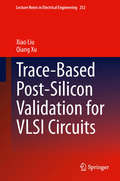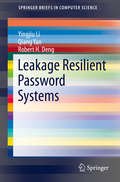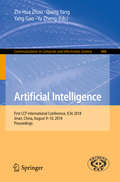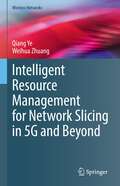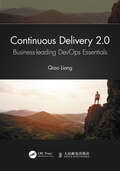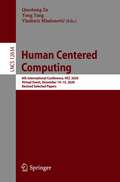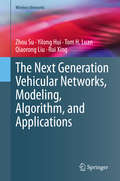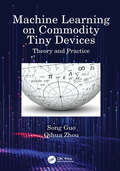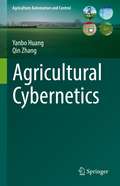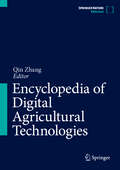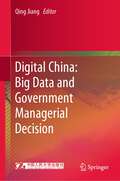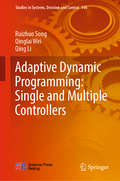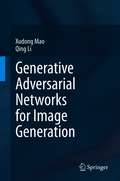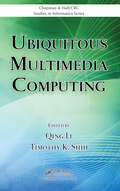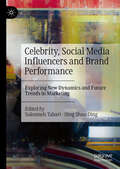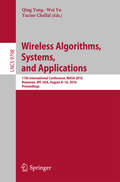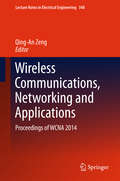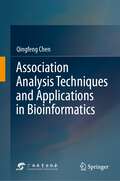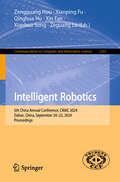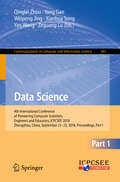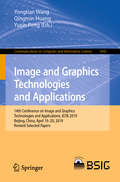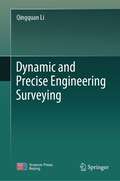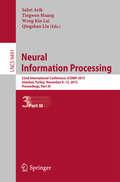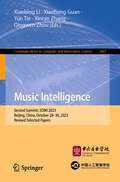- Table View
- List View
Trace-Based Post-Silicon Validation for VLSI Circuits
by Xiao Liu Qiang XuThis book first provides a comprehensive coverage of state-of-the-art validation solutions based on real-time signal tracing to guarantee the correctness of VLSI circuits. The authors discuss several key challenges in post-silicon validation and provide automated solutions that are systematic and cost-effective. A series of automatic tracing solutions and innovative design for debug (DfD) techniques are described, including techniques for trace signal selection for enhancing visibility of functional errors, a multiplexed signal tracing strategy for improving functional error detection, a tracing solution for debugging electrical errors, an interconnection fabric for increasing data bandwidth and supporting multi-core debug, an interconnection fabric design and optimization technique to increase transfer flexibility and a DfD design and associated tracing solution for improving debug efficiency and expanding tracing window. The solutions presented in this book improve the validation quality of VLSI circuits, and ultimately enable the design and fabrication of reliable electronic devices.
Leakage Resilient Password Systems
by Yingjiu Li Qiang Yan Robert H. DengThis book investigates tradeoff between security and usability in designing leakage resilient password systems (LRP) and introduces two practical LRP systems named Cover Pad and ShadowKey. It demonstrates that existing LRP systems are subject to both brute force attacks and statistical attacks and that these attacks cannot be effectively mitigated without sacrificing the usability of LRP systems. Quantitative analysis proves that a secure LRP system in practical settings imposes a considerable amount of cognitive workload unless certain secure channels are involved. The book introduces a secure and practical LRP system, named Cover Pad, for password entry on touch-screen mobile devices. Cover Pad leverages a temporary secure channel between a user and a touch screen which can be easily realized by placing a hand shielding gesture on the touch screen. The temporary secure channel is used to deliver a hidden message to the user for transforming each password symbol before entering it on the touch screen. A user study shows the impact of these testing conditions on the users' performance in practice. Finally, this book introduces a new LRP system named ShadowKey. Shadow Key is designed to achieve better usability for leakage resilient password entry. It leverages either a permanent secure channel, which naturally exists between a user and the display unit of certain mobile devices, or a temporary secure channel, which can be easily realized between a user and a touch screen with a hand-shielding gesture. The secure channel protects the mappings between original password symbols and associated random symbols. Unlike previous LRP system users, Shadow Key users do not need to remember anything except their passwords. Leakage Resilient Password Systems is designed for professionals working in the security industry. Advanced-level students studying computer science and electrical engineering will find this brief full of useful material.
Artificial Intelligence: First CCF International Conference, ICAI 2018, Jinan, China, August 9-10, 2018, Proceedings (Communications in Computer and Information Science #888)
by Yu Zheng Yang Gao Zhi-Hua Zhou Qiang YangThis book constitutes the refereed proceedings of the First CCF International Conference on Artificial Intelligence, CCF-ICAI 2018, held in Jinan, China in August, 2018. The 17 papers presented were carefully reviewed and selected from 82 submissions. The papers are organized in topical sections on unsupervised learning, graph-based and semi-supervised learning, neural networks and deep learning, planning and optimization, AI applications.
Intelligent Resource Management for Network Slicing in 5G and Beyond (Wireless Networks)
by Weihua Zhuang Qiang YeThis book provides a timely and comprehensive study of developing efficient network slicing frameworks in both 5G wireless and core networks. It also presents protocol stack layer perspectives, which includes virtual network topology design, end-to-end delay modeling, dynamic resource slicing, and link-layer and transport-layer protocol customization. This book provides basic principles, concepts and technologies for communication, computing and networking. Optimization and queueing analysis techniques are applied to solving different problems for network slicing illustrated in this book as well.Researchers working in the area of network slicing in 5G networks and beyond, and advanced-level students majoring in electrical engineering, computer engineering and computer science will find this book useful as a reference or secondary textbook. Professionals in industry seeking solutions to resource management for 5G networks and beyond will also want to purchase this book.
Continuous Delivery 2.0: Business-leading DevOps Essentials
by Qiao LiangThe agile transformation is an act of transforming an organization’s form or nature gradually to one that can embrace and thrive in a flexible, collaborative, self-organizing, and fast-changing environment. It seems like most of the companies starting an agile transformation never reach the goal of agility, but there are those few that truly become agile and reap incredible benefits by utilizing DevOps as well. This book introduces the theory and practice of the "double-flywheels model" of Continuous Delivery 2.0: Discovery Loop, which allows information technology (IT) organizations to help businesses figure out the most efficacious ways to develop. Additionally, it explores applications of the Verification Loop that allows IT organizations to deliver value quickly and safely with high quality. Along the way, the book provides an array of insights and case studies that dive into all the aspects of software delivery, and how to implement Continuous Delivery in the most economical way for long-run business development. Features Organization culture and software architecture Business requirement management Pipeline and tooling Branching and releasing strategy Automation strategy Configuration and artefacts management Deployment and production healthy The case studies at the end of the book—scenarios in which the author was personally involved—are explored in depth and meticulously detailed in order to represent typical agile transition scenarios that will benefit all readers.
Human Centered Computing: 6th International Conference, HCC 2020, Virtual Event, December 14–15, 2020, Revised Selected Papers (Lecture Notes in Computer Science #12634)
by Qiaohong Zu Yong Tang Vladimir MladenovićThis book constitutes thoroughly reviewed, revised and selected papers from the 6th International Conference on Human Centered Computing, HCC 2020, held in virtually, due to COVID- 19, in December 2020. The 28 full and 20 short papers presented in this volume were carefully reviewed and selected from a total of 133 submissions.The conference focuses on the following three main themes as follows: Data such as Data Visualization, Big Data, Data Security, Hyper connectivity such as Internet of Things, Cloud Computing, Mobile Network and Collaboration such as Collective Intelligence, Peer Production, Context Awareness and much more.
The Next Generation Vehicular Networks, Modeling, Algorithm and Applications (Wireless Networks)
by Tom H. Luan Zhou Su Yilong Hui Qiaorong Liu Rui XingThis book proposes the novel network envisions and framework design principles, in order to systematically expound the next generation vehicular networks, including the modelling, algorithms and practical applications. It focuses on the key enabling technologies to design the next generation vehicular networks with various vehicular services to realize the safe, convenient and comfortable driving. The next generation vehicular networks has emerged to provide services with a high quality of experience (QoE) to vehicles, where both better network maintainability and sustainability can be obtained than before.The framework design principles and related network architecture are also covered in this book. Then, the series of research topics are discussed including the reputation based content centric delivery, the contract based mobile edge caching, the Stackelberg game model based computation offloading, the auction game based secure computation offloading, the bargain game based security protection and the deep learning based autonomous driving. Finally, the investigation, development and future works are also introduced for designing the next generation vehicular networks.The primary audience for this book are researchers, who work in computer science and electronic engineering. Professionals working in the field of mobile networks and communications, as well as engineers and technical staff who work on the development or the standard of computer networks will also find this book useful as a reference.
Machine Learning on Commodity Tiny Devices: Theory and Practice
by Song Guo Qihua ZhouThis book aims at the tiny machine learning (TinyML) software and hardware synergy for edge intelligence applications. It presents on-device learning techniques covering model-level neural network design, algorithm-level training optimization, and hardware-level instruction acceleration.Analyzing the limitations of conventional in-cloud computing would reveal that on-device learning is a promising research direction to meet the requirements of edge intelligence applications. As to the cutting-edge research of TinyML, implementing a high-efficiency learning framework and enabling system-level acceleration is one of the most fundamental issues. This book presents a comprehensive discussion of the latest research progress and provides system-level insights on designing TinyML frameworks, including neural network design, training algorithm optimization and domain-specific hardware acceleration. It identifies the main challenges when deploying TinyML tasks in the real world and guides the researchers to deploy a reliable learning system.This volume will be of interest to students and scholars in the field of edge intelligence, especially to those with sufficient professional Edge AI skills. It will also be an excellent guide for researchers to implement high-performance TinyML systems.
Agricultural Cybernetics (Agriculture Automation and Control)
by Qin Zhang Yanbo HuangAgricultural systems are uniquely complex systems, given that agricultural systems are parts of natural and ecological systems. Those aspects bring in a substantial degree of uncertainty in system operation. Also, impact factors, such as weather factors, are critical in agricultural systems but these factors are uncontrollable in system management. Modern agriculture has been evolving through precision agriculture beginning in the late 1980s and biotechnological innovations in the early 2000s. Precision agriculture implements site-specific crop production management by integrating agricultural mechanization and information technology in geographic information system (GIS), global navigation satellite system (GNSS), and remote sensing. Now, precision agriculture is set to evolve into smart agriculture with advanced systematization, informatization, intelligence and automation. From precision agriculture to smart agriculture, there is a substantial amount of specific control and communication problems that have been investigated and will continue to be studied.In this book, the core ideas and methods from control problems in agricultural production systems are extracted, and a system view of agricultural production is formulated for the analysis and design of management strategies to control and optimize agricultural production systems while exploiting the intrinsic feedback information-exchanging mechanisms. On this basis, the theoretical framework of agricultural cybernetics is established to predict and control the behavior of agricultural production systems through control theory.
Encyclopedia of Digital Agricultural Technologies
by Qin ZhangDigital agriculture is an emerging concept of modern farming that refers to managing farms using modern Engineering, Information and Communication Technologies (EICT) aiming at increasing the overall efficiency of agricultural production, improving the quantity and quality of products, and optimizing the human labor required and natural resource consumption in operations. This encyclopedia is designed to collect the summaries of knowledge on as many as subjects or aspects relevant to ECIT for digital agriculture, present such knowledge in entries, and arrange them alphabetically by articles titles.Springer Major Reference Works platform offers Live Update capability. Our reference work takes full advantage of this feature, which allows for continuous improvement or revision of published content electronically.The Editorial BoardDr. Irwin R. Donis-Gonzalez, University of California Davis, Dept. Biological and Agricultural Engineering, Davis, USA (Section: Postharvest Technologies)Prof. Paul Heinemann, Pennsylvania State University, Department Head of Agricultural and Biological Engineering, PA, USA (Section: Technologies for Crop Production)Prof. Manoj Karkee, Washington State University, Center for Precision and Automated Agricultural Systems, Washington, USA (Section: Robotics and Automation Technologies)Prof. Minzan Li, China Agricultural University, Beijing, China (Section: Precision Agricultural Technologies)Prof. Dikai Liu, University of Technology Sydney (UTS),Faculty of Engineering & Information Technologies, Broadway NSW, Australia (Section: AI, Information and Communication Technologies)Prof. Tomas Norton, University of Leuven, Dept. of Biosystems, Heverlee Leuven, Belgium (Section: Technologies for Animal and Aquatic Production)Dr. Manuela Zude-Sasse, Leibniz Institute for Agricultural Engineering and Bioeconomy (ATB), Precision Horticulture, Potsdam, Germany (Section: Engineering and Mechanization Technologies)
Digital China: Big Data and Government Managerial Decision
by Qing JiangThis book is the first practical case study on the application of big data in China's government management scenarios, which is important for comprehensively presenting the achievements of China's e-government and digital construction as well as deeply understanding the implementation of big data strategy in China.The author of this book is one of the earliest practitioners engaged in the study of big data applications, and has personally experienced the development, major events, application cases, and industry changes of big data in China. Cases in this book are all actual projects carried out. The author of this book explains the development history of big data she has personally experienced, presenting in an easy-to-understand way the basic concept and characteristics of big data and practical interpretation, which provides important reference for the practical work of government and enterprise managers. The application ideas of big data in management innovation are proposed, and scenarios are described and discussed in terms of accelerating research on sharing big data in government affairs, breaking barriers, realizing data flow information sharing, creating one-stop services, improving the corresponding policy system for sharing big data in government affairs, building public information platform for e-government, and strengthening network and information infrastructure.Especially for the government personnel in departments, this book will give them a better understanding of the charm and value of big data, intuitively understand the utilization and analysis of big data, carry out effective government management and make correct decisions, so as to improve the data literacy of organizations and individuals, form scientific support for their own government's decision-making and management, thus promote the continued construction of digital government, digital China, and digital economy era based on the application of big data.
Adaptive Dynamic Programming: Single and Multiple Controllers (Studies in Systems, Decision and Control #166)
by Qing Li Qinglai Wei Ruizhuo SongThis book presents a class of novel optimal control methods and games schemes based on adaptive dynamic programming techniques. For systems with one control input, the ADP-based optimal control is designed for different objectives, while for systems with multi-players, the optimal control inputs are proposed based on games. In order to verify the effectiveness of the proposed methods, the book analyzes the properties of the adaptive dynamic programming methods, including convergence of the iterative value functions and the stability of the system under the iterative control laws. Further, to substantiate the mathematical analysis, it presents various application examples, which provide reference to real-world practices.
Generative Adversarial Networks for Image Generation
by Qing Li Xudong MaoGenerative adversarial networks (GANs) were introduced by Ian Goodfellow and his co-authors including Yoshua Bengio in 2014, and were to referred by Yann Lecun (Facebook’s AI research director) as “the most interesting idea in the last 10 years in ML.” GANs’ potential is huge, because they can learn to mimic any distribution of data, which means they can be taught to create worlds similar to our own in any domain: images, music, speech, prose. They are robot artists in a sense, and their output is remarkable – poignant even. In 2018, Christie’s sold a portrait that had been generated by a GAN for $432,000. Although image generation has been challenging, GAN image generation has proved to be very successful and impressive. However, there are two remaining challenges for GAN image generation: the quality of the generated image and the training stability. This book first provides an overview of GANs, and then discusses the task of image generation and the details of GAN image generation. It also investigates a number of approaches to address the two remaining challenges for GAN image generation. Additionally, it explores three promising applications of GANs, including image-to-image translation, unsupervised domain adaptation and GANs for security. This book appeals to students and researchers who are interested in GANs, image generation and general machine learning and computer vision.
Ubiquitous Multimedia Computing (Chapman & Hall/CRC Studies in Informatics Series)
by Qing Li Timothy K. ShinComputing is ubiquitous and if you think otherwise, that in itself might be the best evidence that it is so. Computers are omnipresent in modern life and the multimedia computing environment of today is becoming more and more seamless.Bringing together contributions from dozens of leading experts, Ubiquitous Multimedia Computing educates readers on
Celebrity, Social Media Influencers and Brand Performance: Exploring New Dynamics and Future Trends in Marketing
by Saloomeh Tabari Qing Shan DingCelebrity endorsement has shown to be an effective way enhancing brand-related attitudes, reinforcing behavioural intentions, and shaping brand perceptions. Indeed, companies devote a lot of resources on celebrity endorsement to exploit emotional bonds between consumers and brands in order to accomplish their desired brand image and increase brand awareness, differentiation, and brand loyalty. In short, brands that are endorsed by a favourite celebrity and influencer become more credible and trustworthy. This edited book examines this new era of marketing by focusing on the impact of employing celebrities, SMIs and virtual influencers to endorse the brand as a key advertising tactic. In particular, it focuses on the rise of social media usage and the corresponding changes in advertising strategies in the digital era. As well as exploring this rise of celebrity influencers and their value, the book also takes a critical lens, examining their roles in fuelling the growth of materialism, causing mental health issues among adolescents, and aiding the development of fast fashion. With this balanced and comprehensive approach, this book is an essential resource for anyone interested in the future of advertising.
Wireless Algorithms, Systems, and Applications
by Qing Yang Wei Yu Yacine ChallalThis book constitutes the proceedings of the 11th International Conference on Wireless Algorithms, Systems, and Applications, WASA 2016, held in Bozeman, MT, USA, in August 2016. The 50 full papers and 9 invited papers presented werde carefully reviewed and selected from 148 submissions. WASA is designed to be a forum for theoreticians, system and application designers, protocol developers and practitioners to discuss and express their views on the current trends, challenges, and state-of-the-art solutions related to various issues in wireless networks. Topics of interests include, but not limited to, effective and efficient state-of-the-art algorithm design and analysis, reliable and secure system development and implementations, experimental study and testbed validation, and new application exploration in wireless networks.
Wireless Communications, Networking and Applications
by Qing-An ZengThis book is based on a series of conferences on Wireless Communications, Networking and Applications that have been held on December 27-28, 2014 in Shenzhen, China. The meetings themselves were a response to technological developments in the areas of wireless communications, networking and applications and facilitate researchers, engineers and students to share the latest research results and the advanced research methods of the field. The broad variety of disciplines involved in this research and the differences in approaching the basic problems are probably typical of a developing field of interdisciplinary research. However, some main areas of research and development in the emerging areas of wireless communication technology can now be identified. The contributions to this book are mainly selected from the papers of the conference on wireless communications, networking and applications and reflect the main areas of interest: Section 1 - Emerging Topics in Wireless and Mobile Computing and Communications; Section 2 - Internet of Things and Long Term Evolution Engineering; Section 3 - Resource Allocation and Interference Management; Section 4 - Communication Architecture, Algorithms, Modeling and Evaluation; Section 5 - Security, Privacy, and Trust; and Section 6 - Routing, Position Management and Network Topologies.
Association Analysis Techniques and Applications in Bioinformatics
by Qingfeng ChenAdvances in experimental technologies have given rise to tremendous amounts of biology data. This not only offers valuable sources of data to help understand biological evolution and functional mechanisms, but also poses challenges for accurate and effective data analysis. This book offers an essential introduction to the theoretical and practical aspects of association analysis, including data pre-processing, data mining methods/algorithms, and tools that are widely applied for computational biology. It covers significant recent advances in the field, both foundational and application-oriented, helping readers understand the basic principles and emerging techniques used to discover interesting association patterns in diverse and heterogeneous biology data, such as structure-function correlations, and complex networks with gene/protein regulation. The main results and approaches are described in an easy-to-follow way and accompanied by sufficientreferences and suggestions for future research. This carefully edited monograph is intended to provide investigators in the fields of data mining, machine learning, artificial intelligence, and bioinformatics with a profound guide to the role of association analysis in computational biology. It is also very useful as a general source of information on association analysis, and as an overall accompanying course book and self-study material for graduate students and researchers in both computer science and bioinformatics.
E-Commerce Industry Chain: Theory and Practice (Advanced Studies in E-Commerce)
by Yun Zhang Zhongjun Li Qinghong ShuaiThis book focuses on e-commerce industry chain based on the whole process of e-commerce activities (production, distribution, circulation, consumption). It extracted the supporting technology and operation process of e-commerce into general principles in the form of mathematical analysis, helping readers to build the frame of theory and practice of activity link of e-commerce. This book stands on the concepts, carries on the innovation and cases in the practice, helping readers to establish a relatively complete e-commerce system. Also the arising challenges and issues are discussed, and guide for the future e-commerce development under the new situation is presented.
Intelligent Robotics: 5th China Annual Conference, CIRAC 2024, Dalian, China, September 20–22, 2024, Proceedings (Communications in Computer and Information Science #2355)
by Xianhua Song Zeguang Lu Qinghua Hu Xin Fan Zengguang Hou Xianping FuThis book constitutes selected papers presented during the 5th China Annual Intelligent Robotics Conference, CIRAC 2024, held in Dalian, China, in September 2024. The 28 full papers presented in this volume were carefully reviewed and selected from 96 submissions. They are grouped into the following topics: Deep Learning Architecture; Low-Level Vision; Multi-modal learning; Pattern Recognition; Robotics; and Signal processing.
Data Science: 4th International Conference of Pioneering Computer Scientists, Engineers and Educators, ICPCSEE 2018, Zhengzhou, China, September 21-23, 2018, Proceedings, Part I (Communications in Computer and Information Science #901)
by Yan Wang Weipeng Jing Xianhua Song Zeguang Lu Yong Gan Qinglei ZhouThis two volume set (CCIS 901 and 902) constitutes the refereed proceedings of the 4th International Conference of Pioneering Computer Scientists, Engineers and Educators, ICPCSEE 2018 (originally ICYCSEE) held in Zhengzhou, China, in September 2018. The 125 revised full papers presented in these two volumes were carefully reviewed and selected from 1057 submissions. The papers cover a wide range of topics related to basic theory and techniques for data science including mathematical issues in data science, computational theory for data science, big data management and applications, data quality and data preparation, evaluation and measurement in data science, data visualization, big data mining and knowledge management, infrastructure for data science, machine learning for data science, data security and privacy, applications of data science, case study of data science, multimedia data management and analysis, data-driven scientific research, data-driven bioinformatics, data-driven healthcare, data-driven management, data-driven eGovernment, data-driven smart city/planet, data marketing and economics, social media and recommendation systems, data-driven security, data-driven business model innovation, social and/or organizational impacts of data science.
Image and Graphics Technologies and Applications: 14th Conference on Image and Graphics Technologies and Applications, IGTA 2019, Beijing, China, April 19–20, 2019, Revised Selected Papers (Communications in Computer and Information Science #1043)
by Yongtian Wang Yuxin Peng Qingmin HuangThis book constitutes the refereed proceedings of the 14th Conference on Image and Graphics Technologies and Applications, IGTA 2019, held in Beijing, China in April, 2019. The 66 papers presented were carefully reviewed and selected from 152 submissions. They provide a forum for sharing progresses in the areas of image processing technology; image analysis and understanding; computer vision and pattern recognition; big data mining, computer graphics and VR, as well as image technology applications.
Dynamic and Precise Engineering Surveying
by Qingquan LiDriven by the increasingly expanding needs of infrastructure construction, operation and maintenance, as well as the rapid developments of intelligent sensing and information technology, precise engineering surveying has been transformed from static, discrete, and manual into dynamic, continuous, and intelligent ways. This transformation leads to an advanced multidisciplinary field, dynamic and precise engineering surveying, on which the author has worked for over two decades. This book systematically summarizes the fundamentals, methods, and applications in dynamic and precise engineering surveying. The contents mainly include two parts: the first part introduces principles and methods of dynamic and precise engineering surveying; the second part presents representative applications in which innovative methods and advanced equipment are applied in the construction, operation and maintenance of mega and complex infrastructures.Readers engaged in surveying and mapping, civil engineering, water conservancy engineering, railway engineering, electronic information, and computer science, including undergraduates, graduates, researchers and engineers, will find it an informative reference.
Neural Information Processing
by Sabri Arik Tingwen Huang Weng Kin Lai Qingshan LiuThe four volume set LNCS 9489, LNCS 9490, LNCS 9491, andLNCS 9492 constitutes the proceedings of the 22nd International Conference onNeural Information Processing, ICONIP 2015, held in Istanbul, Turkey, inNovember 2015. The 231 full papers presented were carefully reviewed andselected from 375 submissions. The 4 volumes represent topical sectionscontaining articles on Learning Algorithms and Classification Systems;Artificial Intelligence and Neural Networks: Theory, Design, and Applications;Image and Signal Processing; and Intelligent Social Networks.
Music Intelligence: Second Summit, SOMI 2023, Beijing, China, October 28–30, 2023, Revised Selected Papers (Communications in Computer and Information Science #2007)
by Xiaobing Li Yun Tie Xiaohong Guan Xinran Zhang Qingwen ZhouThis book constitutes the refereed proceedings of the Second Summit on Music Intelligence, SOMI 2023, held in Beijing, China, during October 28–30, 2023.The 10 full papers included in this book were carefully reviewed and selected from 27 submissions. They were organized in topical sections as follows: Music, Neural Science and Music Therapy, Multimodality in Music and Music Generation.
